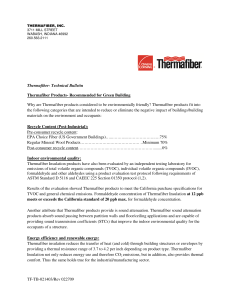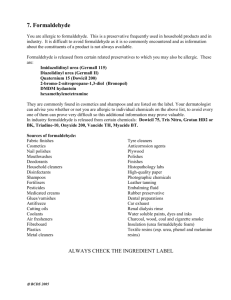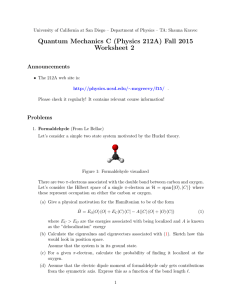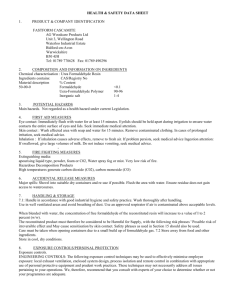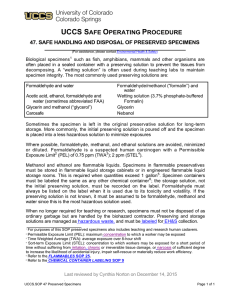Formaldehyde Emissions of Gasoline Mixed with Alcohol Fuels and
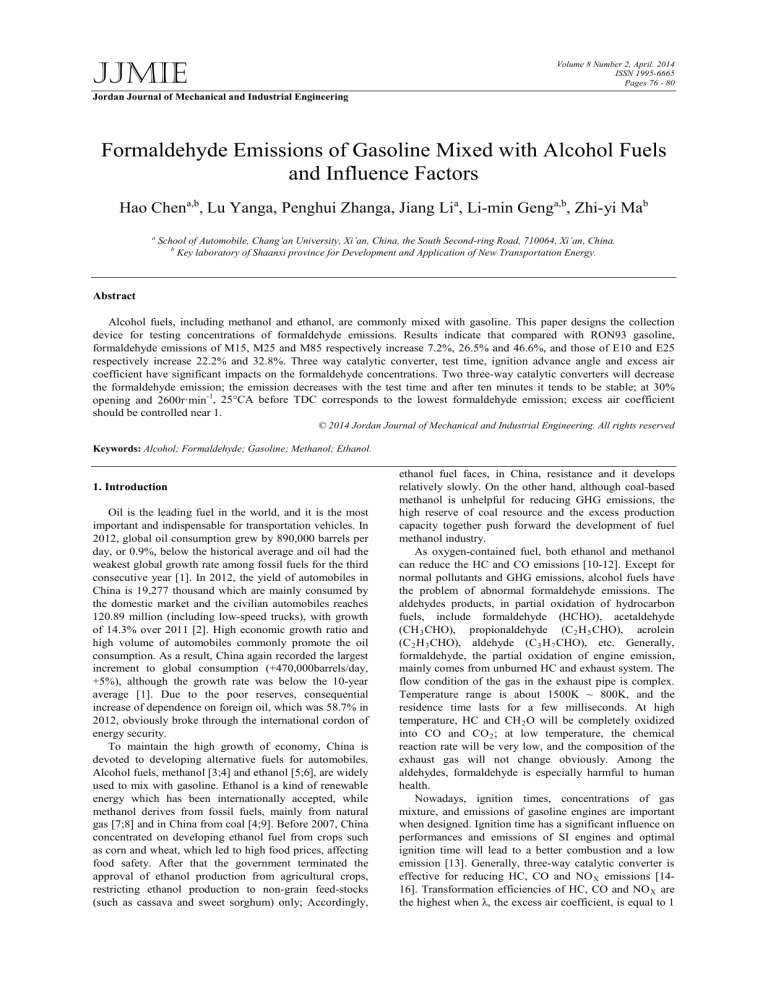
JJMIE
Jordan Journal of Mechanical and Industrial Engineering
Volume 8 Number 2, April. 2014
ISSN 1995-6665
Pages 76 - 80
Formaldehyde Emissions of Gasoline Mixed with Alcohol Fuels and Influence Factors
Hao Chen
a,b
,
Lu Yanga, Penghui Zhanga, Jiang Li
a
, Li-min Geng
a,b
, Zhi-yi Ma
b a
School of Automobile, Chang’an University, Xi’an, China, the South Second-ring Road, 710064, Xi’an, China. b
Key laboratory of Shaanxi province for Development and Application of New Transportation Energy.
Abstract
Alcohol fuels, including methanol and ethanol, are commonly mixed with gasoline. This paper designs the collection device for testing concentrations of formaldehyde emissions. Results indicate that compared with RON93 gasoline, formaldehyde emissions of M15, M25 and M85 respectively increase 7.2%, 26.5% and 46.6%, and those of E10 and E25 respectively increase 22.2% and 32.8%. Three way catalytic converter, test time, ignition advance angle and excess air coefficient have significant impacts on the formaldehyde concentrations. Two three-way catalytic converters will decrease the formaldehyde emission; the emission decreases with the test time and after ten minutes it tends to be stable; at 30% opening and 2600r·min -1 , 25°CA before TDC corresponds to the lowest formaldehyde emission; excess air coefficient should be controlled near 1.
© 2014 Jordan Journal of Mechanical and Industrial Engineering. All rights reserved
Keywords: Alcohol; Formaldehyde; Gasoline; Methanol; Ethanol.
1.
Introduction
Oil is the leading fuel in the world, and it is the most important and indispensable for transportation vehicles. In
2012, global oil consumption grew by 890,000 barrels per day, or 0.9%, below the historical average and oil had the weakest global growth rate among fossil fuels for the third consecutive year [1]. In 2012, the yield of automobiles in
China is 19,277 thousand which are mainly consumed by the domestic market and the civilian automobiles reaches
120.89 million (including low-speed trucks), with growth of 14.3% over 2011 [2]. High economic growth ratio and high volume of automobiles commonly promote the oil consumption. As a result, China again recorded the largest increment to global consumption (+470,000barrels/day,
+5%), although the growth rate was below the 10-year average [1]. Due to the poor reserves, consequential increase of dependence on foreign oil, which was 58.7% in
2012, obviously broke through the international cordon of energy security.
To maintain the high growth of economy, China is devoted to developing alternative fuels for automobiles.
Alcohol fuels, methanol [3;4] and ethanol [5;6], are widely used to mix with gasoline. Ethanol is a kind of renewable energy which has been internationally accepted, while methanol derives from fossil fuels, mainly from natural gas [7;8] and in China from coal [4;9]. Before 2007, China concentrated on developing ethanol fuel from crops such as corn and wheat, which led to high food prices, affecting food safety. After that the government terminated the approval of ethanol production from agricultural crops, restricting ethanol production to non-grain feed-stocks
(such as cassava and sweet sorghum) only; Accordingly, ethanol fuel faces, in China, resistance and it develops relatively slowly. On the other hand, although coal-based methanol is unhelpful for reducing GHG emissions, the high reserve of coal resource and the excess production capacity together push forward the development of fuel methanol industry.
As oxygen-contained fuel, both ethanol and methanol can reduce the HC and CO emissions [10-12]. Except for normal pollutants and GHG emissions, alcohol fuels have the problem of abnormal formaldehyde emissions. The aldehydes products, in partial oxidation of hydrocarbon fuels, include formaldehyde (HCHO), acetaldehyde
(CH
3
CHO), propionaldehyde (C
2
H
5
CHO), acrolein
(C
2
H
3
CHO), aldehyde (C
3
H
7
CHO), etc. Generally, formaldehyde, the partial oxidation of engine emission, mainly comes from unburned HC and exhaust system. The flow condition of the gas in the exhaust pipe is complex.
Temperature range is about 1500K ~ 800K, and the residence time lasts for a few milliseconds. At high temperature, HC and CH
2
O will be completely oxidized into CO and CO
2
; at low temperature, the chemical reaction rate will be very low, and the composition of the exhaust gas will not change obviously. Among the aldehydes, formaldehyde is especially harmful to human health.
Nowadays, ignition times, concentrations of gas mixture, and emissions of gasoline engines are important when designed. Ignition time has a significant influence on performances and emissions of SI engines and optimal ignition time will lead to a better combustion and a low emission [13]. Generally, three-way catalytic converter is effective for reducing HC, CO and NO
X
emissions [14-
16]. Transformation efficiencies of HC, CO and NO
X
are the highest when
λ, the excess air coefficient, is equal to 1
77
(air/fuel ratio is equal to 14.7). Therefore, under closedloop control oxygen sensor is installed in the exhaust system to send feedback signal to achieve the precise control for fluctuation range of
λ (λ=1±0.03) [17-18].
This paper firstly studies the formaldehyde emissions of gasoline mixed with alcohol fuels to obtain the rules among the different fuels. Because the formaldehyde emissions are not considered in the engine design process, the parameters such as ignition times and excess air coefficient are suitable for engines fueled with methanol gasoline should be concerned. Accordingly, the influence factors of formaldehyde emissions are deeply researched.
2.
Test Conditions
2.1.
© 2014 Jordan Journal of Mechanical and Industrial Engineering. All rights reserved - Volume 8, Number 2 (ISSN 1995-6665)
Test Engine and Instruments
Flyer M-TCE is a closed-loop control engine and its major parameters are listed in table 1.
Table 1.
Engine parameters
Engine
Type
M-TCE
Inline 3 cylinder , multi-point EFI
Discharge/ mL 796
Maximum power/ kW (r·min
-1
) 37.5(6000)
Maximum torque/ N·m (r·min
-1
) 68.6(4600)
Compression ratio 9.3
2.2.
Formaldehyde Collection and Test
2.2.1.
Formaldehyde Collection Device
The test used an external pipe providing fresh air to dilute the emissions. The dilution ratio between fresh air flow and exhaust gas flow is 5:1, which ensures that formaldehyde concentrations will not exceed the test range. They are respectively pumped by two vacuum pumps connected to the 12V DC power supply and in the blends tube emissions are diluted and mixed for test.
Sketch of the experimental setup is shown in Figure 1.
Dynamometer
M-TCE
Engine
Exhaust Flow Meter Pump A
Blends Tube
HCHO
Analyzer
Air Flow Meter Pump B
2.2.2.
Formaldehyde Analyzer
Figure 1.
Test engine and instruments
Formaldehyde concentrations in engine emissions can hardly be tested. In China, the phenol reagent method is adopted in the national standard (GB/T18204.26-2000) for testing the formaldehyde concentration in the air.
Formaldehyde reacts with the phenol reagent, producing triazine which is oxidized by ferric iron to form a blue compound ion in acid solution. According to the color depth, colorimetry is used for quantitative calculation. This paper uses a portable indoor air testing instrument
(GDYK-201S HCHO analyzer) for testing formaldehyde concentration.
C
0
: formaldehyde analyzer display value, mg·L
-1
;
V
0
: standard condition (20ºC, a pressure sampling volume), L;
10: Determination of colorimetric bottle solution volume, mL;
V
T
: sampling volume, L;
T: sampling temperature, ºC;
P: sampling point of atmospheric pressure, kPa.
3.
Results and Discussion
3.1.
Formaldehyde Emissions of Gasoline Mixed with
Alcohol Fuels
2.3.
Test Fuels
RON93 gasoline, methanol and ethanol are prepared for blending to get different mixture fuels. M15, M25 and
M85 indicate that the methanol volume proportions are respectively 15%, 25% and 85%. E10 and E25 mean that the ethanol volume contents are 10% and 25%.
2.4.
Concentration Calculation
The concentrations of formaldehyde at different temperatures and different pressures are calculated as (1):
C
C
= 0 ×
10
=
V
0 V
T
×
C
0
273
273
+
T
×
P
101.3
×
10
(1)
C: the actual measured formaldehyde concentration, mg·m
-3
;
Formaldehyde emissions of gasoline mixed with alcohol fuels are shown in Figure 2. Formaldehyde is a kind of intermediate product in the combustion process.
Temperature in the cylinder is so high that it is not suitable for the generation of formaldehyde, because the existing time in the high temperature gas is extremely short.
Accordingly, it is mainly generated in the exhaust pipe from unburned methanol, and its generation depends on the amount of unburned methanol, exhaust temperature and reaction time. Formaldehyde derives from two reactions: oxidation which is an exothermic reaction shown in (2), and dehydrogenation which is an endothermic reaction as (3).
CH OH
3
+
1
2
O
2
→
CH O
2
+
H O
2
(2)
CH OH
3
→
CH O
2
+
H
2
(3)
© 2014 Jordan Journal of Mechanical and Industrial Engineering. All rights reserved - Volume 8, Number 2 (ISSN 1995-6665) 78
Compared with RON93, formaldehyde emissions of
M15, M25 and M85 respectively increase 7.2%, 26.5% and 46.6%; those of E10 and E25 respectively increase
22.2% and 32.8%. With the increase of methanol content, quality of unburned methanol increases and, thus, the formaldehyde emission increases. For ethanol, the rule is the same. The maximum value of formaldehyde for
RON93 in the two curves are different. Influence Factors of Formaldehyde Emissions
3.1.1.
Number of Three Way Catalytic Converter
At 30% opening of throttle valve and 2600r•min
-1
of engine speed, formaldehyde emissions of different fuels are tested before a three-way catalytic converter (TWCC), after TWCC, and after two TWCCs, respectively, as shown in table 2. For all the fuels, different concentration values of formaldehyde emissions are obtained at different sampling points. Formaldehyde concentrations after
TWCC are obviously higher than those before TWCC; however, after two TWCCs, the concentrations are apparently lower. For example, before TWCC, the formaldehyde emission concentration of M15 is 3.89 mg•m
-3
, after TWCC, the concentration is 7.78 mg•m
-3
, and after two TWCCs, the value is 2.49 mg/m 3 . After
TWCC, formaldehyde emissions of all the fuels are about twice as much as those before TWCC, mainly because that the unburned hydrocarbons and alcohols are partially oxidized into formaldehydes. When a TWCC is added, as intermediate products, formaldehydes decrease from
23.8% to 36.0% (for different fuels), because formaldehyde emissions are further oxidized into carbon dioxides and water.
13.0
12.0
11.0
10.0
9.0
8.0
7.0
RON93
M15
M25
M85
13.0
12.0
11.0
10.0
9.0
8.0
7.0
6.0
5.0
4.0
RON93
E10
E25
6.0
2 4 6 8 10 12 14 16
Power/ kW
2 4 6 8 10
Power/ kW
12 14
(a) Methanol gasoline and gasoline (b) Ethanol gasoline and gasoline
Figure 2. Formaldehyde emissions
16
Table 2.
Influence of three way catalytic converter on formaldehyde emissions
Sampling point
Before three way catalytic converter (mg·m
-3
)
After three way catalytic converter (mg·m
-3
)
After two three way catalytic converters (mg·m
-3
)
RON93
3.24
7.11
2.07
3.1.2.
Test Time
M15 and E10 are chosen for a comparison with
RON93, shown in figure 3. Rules for other mixtures are the same. When the test time is short, the concentration values of formaldehyde emissions of different fuels are high. The concentrations decrease obviously with the test time. Ten minutes is the optimal time for a formaldehyde test, because the values tend to be stable and unchangeable. The result provides a correct and effective test condition for formaldehyde emissions.
3.1.3.
Ignition Advance Angle
In a certain operation condition, there is a best ignition advance angle which corresponds to the lowest formaldehyde emission. Figure 4 indicates variation rules of formaldehyde emissions with ignition advance angle. At
30% opening and 2600r•min
-1
it is 25°CA before the TDC.
M15
3.89
7.78
2.49
M25
4.61
9.16
3.36
M85
5.28
11.08
4.03
E10 E25
4.13 5.07
8.02 10.02
2.85 3.83
11
10
9
8
7
6
5
RON93
M15
2 4 6 8 10 12 14 16
Test time/ min
Figure 3.
Formaldehyde emissions with test time
Based on this, the advance or the delay of the ignition time will result in an increase of the formaldehyde emissions.
When ignition advances, combustion advances as well, which leads to high negative work in the compress stroke.
To achieve the same power, the fuel consumption increases. Unburned methanol and unburned hydrocarbons rise. As a result, they will surely be partially oxidized and
79 © 2014 Jordan Journal of Mechanical and Industrial Engineering. All rights reserved - Volume 8, Number 2 (ISSN 1995-6665) formaldehyde emissions increase. If the ignition delays, after burning improves, which decreases the thermal efficiency. Similarly, the fuel consumptions and the emissions increase.
11
10
9
8
7
6
5
Figure 4.
RON93
M15
E10
-40 -30 -20 -10 0 10 20 30 40 50
Ignition advance angle/ °CA
Formaldehyde emissions with ignition advance angle
Table 3.
Influence of excess air coefficient on formaldehyde emissions
Virtual voltage Excess air coefficient RON93 (mg·m
-3
)
3.3 (V)
3.6 (V)
4.2 (V)
4.5 (V)
4.8 (V)
1.289
1.187
0.987
0.89
0.801
17.64
11.45
6.74
9.20
16.93
3.1.4.
Concentration of Gas Mixture
Excess air coefficient is adjusted within the range from
0.97 to 1.03. The test controlled
λ value, by applying the virtual inlet air pressure signal and fuel injection quantity, can be well controlled. Consequently, the
λ values can be adjusted. However, a closed-loop control is adopted in today’s gasoline engine and the excess air coefficient is automatically adjusted when the ECU received the feedback signal from the oxygen sensor. The concentration of the mixed gas will be self-corrected to the above range.
Therefore, in order to prevent the automatic correction of fuel injection quantity, the oxygen sensor is broken and the engine is under the open-loop control. Thus, the
λ value can be changed as expected. The test data listed in table 3 show the formaldehyde emissions of the three fuels are the lowest when the excess air coefficient is equal to 0.987.
Lower or higher excess air coefficient will increase the emission. Both rich mixture and lean mixture will result in the incomplete combustion and formaldehyde emissions will increase.
M15 (mg·m
-3
)
18.25
13.98
7.65
10.25
17.02
E10 (mg·m
-3
)
19.72
14.65
8.01
10.96
18.34
4.
Conclusion
Methanol gasoline and ethanol gasoline are the major alternative fuels for road transport vehicles in China. They are considered as clean fuels due to the high oxygen contents which contribute to the lower HC and CO emissions compared with gasoline. However, abnormal emissions, especially the formaldehyde emissions, increase obviously with the volume content.
A three-way catalytic converter is effective for reducing CO, HC and NO
X
emissions. However, it contributes to the high formaldehyde emission. Solution method is adding a converter and the emission decreases obviously.
At 30% opening and 2600r·min
-1 , the ignition advance angle can be adjusted to 25°CA before TDC for the lowest formaldehyde emission. Comprehensive optimal data of ignition advance angles can be obtained through test at different loads and speeds.
Excess air coefficient is very important to engine performances and emissions. It can be proved that formaldehyde emissions are also lowest when
λ is close to
1.
For experimenting the formaldehyde emissions, ten minutes is suggested for the test time.
Acknowledgement
The Project Supported by Natural Science Basic
Research Plan in Shaanxi Province of China (Program No.
2014JQ7268) and the Special Fund for Basic Scientific
Research of Central Colleges, Chang’an University
(2013G1221018, 2013G3224019, CHD2012JC049).
References
[1] BP P.L.C.. BP Statistical Review of World Energy 2012.
Retrieved January 31, 2013 from the World Wide Web: http://www.bp.com/content/dam/bp/pdf/statisticalreview/statistical_review_of_world_ energy_2013.pdf.
[2] NBSC (National Bureau of Statistics of China). 2004-2012 statistical bulletin of national economic and social development of the P.R.C. From the World Wide Web: http://www.stats.gov.cn/ english/statisticaldata/yearlydata/.
[3] Y.H. Shen, “Methanol Gasoline Development in Foreign
Countries and Enlightenment to China”. Sino-global Energy,
No. 12, 2010, 23-28 (in Chinese).
[4] C.J. Yang, B.J. Robert, “China’s growing methanol economy and its implications for energy and the environment”. Energy
Policy, Vol. 41, 2012, 878-884.
[5] A.A. Adolf, S. Tomas, G. Andrea , K. Johan , S.C. LennyKoh,
M.M. Simon, “Biofuels and their potential to aid the UK towards achieving emissions reduction policy targets”.
Renewable and Sustainable Energy Reviews, Vol. 16, No. 7,
2012, 5414-5422.
[6] Luciano Charlita de Freitas, Shinji Kaneko, “Ethanol demand in Brazil: Regional approach”. Energy Policy, Vol. 39, No. 5,
2011, 2289-2298.
[7] Z. Wang, “Experimental Study on Combustion & Emissions of
SI Engine Powered by Different Methanol-Gasoline Fuels”.
Master degree thesis. 2010. Tsinghua University.
[8] K.S. Anita, K.S. Athena, “Wind-hydrogen utilization for methanol production: An economy assessment in Iran”.
Renewable and Sustainable Energy Reviews, Vol. 15, No. 8,
2011, 3570-3574.
[9] F. Zhang, S.J. Shuai, Z. Wang, X. Zhang, J.X. Wang, “A detailed oxidation mechanism for the prediction of formaldehyde emission from methanol-gasoline SI engines”.
Proceedings of the Combustion Institute, Vol. 33, No. 2,
2011, 3151-3158.
© 2014 Jordan Journal of Mechanical and Industrial Engineering. All rights reserved - Volume 8, Number 2 (ISSN 1995-6665)
[10] Y.C. Yao, J.H. Tsai, I.T Wang, “Emissions of gaseous pollutant from motorcycle powered by ethanol–gasoline blend”. Applied Energy, Vol. 102, 2013, 93–100.
[11] L.W. Jia, M.Q. Shen, J. Wang, M.Q. Lin, “Influence of ethanol–gasoline blended fuel on emission characteristics from a four-stroke motorcycle engine”. Journal of Hazardous
Materials, Vol. 123, No. 1-3, 2005, 29–34.
[12] Q.H. Zhao, X.P. Wu, “CO/HC emissions analysis of engine used ethanol gasoline”. Automobile Applied Technology,
No.8, 2012, 35-37(in Chinese).
[13] J. Li, C.M. Gong, Y. Su, H.L. Dou, X.J. Liu, “Effect of injection and ignition timings on performance and emissions from a spark-ignition engine fueled with methanol”, Fuel,
Vol. 89, No. 12, 2010, 3919-3925.
[14] H. CHEN, Q.H. MA, L.M. GENG, “Influence of oxygen sensor on em ission and conversion efficiency”. Journal of
Zhengzhou University (Engineering Science), Vol. 28, No. 2,
2007, 93-96(in Chinese).
80
[15] N.S. Asad, Y.S. Ge, H. Zhao, “Aldehyde and BTX Emissions from a Light Duty Vehicle Fueled on Gasoline and Ethanol-
Gasoline Blend, Operating with a ThreeWay Catalytic
Converter”. Jordan Journal of Mechanical and Industrial
Engineering, Vol. 4, No. 3, 2010, 340-345.
[16] A. Takigawa, A. Matsunami, N. Arai, “Methane emission from automobile equipped with three-way catalytic converter while driving”. Energy, Vol. 30, No. 2-4, 2005, 461-473.
[17] X.Y. Dong, T. Cheng, “Research of air/fuel ratio PI control and vehicle emission optimization, Equipment manufacturing technology”, No.3, 2012, 4-7(in Chinese).
[18] F.H. Ma, J.J. Wang, W. Chen, X. Wu, Y. Li, Y. Wang,
“Emission characteristic of turbocharged lean burn CNG engine”. Chinese Internal Combustion Engine Engineering,
Vol. 29, No. 2, 2008, 10-14(in Chinese).
